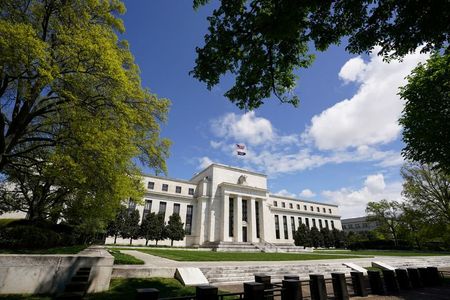
FILE PHOTO: The Federal Reserve building is set against a blue sky, amid the coronavirus disease (COVID-19) outbreak, in Washington, U.S., May 1, 2020.
WASHINGTON: The US economy continued to recover at a slight to modest pace through early October as consumers bought homes and increased spending, but the picture varied greatly from sector to sector, the Federal Reserve said on Wednesday (Oct 21).
The Fed’s Beige Book report was decidedly more upbeat than the September version, with more districts using the words “positive” and “optimistic” to describe various aspects of their local economies.
Still, the anecdotal report of business conditions across Fed districts painted a picture of an uneven recovery from the pandemic-induced downturn.
On consumer spending for instance, the Chicago Fed reported it had “increased robustly”, the New York Fed said it had “levelled off”, and the Kansas City Fed described it as having “declined modestly”.
“Districts characterised the outlooks of contacts as generally optimistic or positive, but with a considerable degree of uncertainty,” the Fed said in the report.
Manufacturing activity increased at a “moderate” pace and consumer spending grew, but some districts said retail spending was beginning to level off.
The Fed found that steady demand for homes boosted the residential real estate market and lifted overall loan demand. But the commercial real estate market, in contrast, continued to “deteriorate” in many districts with the exception of warehouses and industrial space.
Low inventory of homes and cars may have limited sales growth in those markets to different degrees, some districts said. Banking contacts in many districts also expressed concern that delinquencies could rise, though they have so far remained stable.
The Fed’s survey was conducted in its 12 districts from September through Oct 9.
SOME LABOUR MARKET TIGHTNESS
The employment scene was mixed. Hiring continued at varied paces across sectors and Fed districts, but the trend of temporary layoffs becoming permanent persisted.
A COVID-19 survey by the Philadelphia Fed summed it up: “Recalls of furloughed workers have slowed – to 5 per cent in September from 13 per cent in July.
Meanwhile, the share of firms issuing permanent layoffs edged up to 7 per cent in September from 6 per cent in July, while the share issuing new furloughs edged down to 5 per cent from 6 per cent.”
And despite high overall unemployment through the nation, most districts reported “tight” labour markets.
Firms, the report showed, are responding in some cases by raising wages or increasing flexibility for workers dealing with childcare issues; others are increasing automation; and one firm in the St Louis Fed district reported “having to threaten furloughed employees’ healthcare benefits to pressure enough to return to work”.
After declining from late July to early September, coronavirus infections are on the rise again in the United States. Thirty-four out of 50 states have seen new cases increase for at least two weeks in a row, up from 29 the prior week, according to a Reuters analysis.
Cooling temperatures may usher more consumers indoors, potentially leading to more cases. Restaurants in many districts that benefited from outdoor seating over the summer months said they worried colder weather could hurt sales.
House Speaker Nancy Pelosi, a Democrat, reiterated Wednesday she was “optimistic” that Congress can hash out another aid package to help struggling households and businesses before the Nov 3 election, but doubts linger whether Republicans will get on board.
Fed policymakers pledged at their September meeting to keep interest rates near zero until inflation is on track to stay moderately above the central bank’s 2 per cent target for some time and until the labour market is closer to full employment.
Officials are set to meet again shortly after the presidential election, concluding their next gathering on Nov 5.
Overall, the report pointed to the kind of uneven recovery that Fed officials have warned may become a more-or-less permanent state of affairs unless more federal pandemic relief is brought to bear.
“While the strong bounceback in activity from the initial devastation of COVID-19 was heartening, the recovery thus far has been highly uneven, and the path ahead is highly uncertain,” Fed Governor Lael Brainard said earlier Wednesday, adding failure to deliver more fiscal aid is the biggest downside risk to her outlook.

